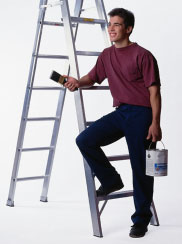by Kearston Baalman
If you aren’t tall, then needing help reaching something is a common daily occurrence and a portable stepladder, for example, may be something you use everyday. Therefore, ladder safety is something that hits very close to home. Many people underestimate the dangers associated with such a simple tool as a ladder. More than 200,000 people are injured in ladder accidents each year with more than 300 deaths. These accidents and deaths can most often be prevented when using basic ladder safety tips. To make sure you are not just a statistic, below are some simple “rules of the road” to follow when using a ladder.
-
Make sure you completely understand the dynamics of your specific ladder. Examining it and reading the instructions would be a wonderful and safe way to begin. There are drastic differences between extension ladders, stepladders, multipurpose ladders, telescoping ladders, and platform ladders.
-
For ladders such as stepladders, the arms, or spreaders, between the opposite legs should be completely locked before climbing. This will ensure that the ladder will not collapse when weight is applied.
-
Be sure to use the right ladder for the job. There are a wide variety of ladder types, including but not limited to: step, platform, telescoping, multipurpose, extension. Make you use the ladder that is the most appropriate for the job to ensure success.

-
Always inspect your ladder before use. A ladder that has not been used for quite some time, despite where it is stored, could be subject to deterioration. Check the rungs for damage. The ladder should be clean and sturdy. Remember, if your ladder is damaged, it is better to invest in a new one than to invest in medical bills.
-
Don’t be lazy! When you need to move the ladder to a new location, GET DOWN FIRST! Don’t try to move the ladder while you are still mounted on it. You may be trying to save a few minutes, but you will pay for it with a trip to the emergency room.
-
If you are employed at a job that requires the use of a ladder, be sure to check with your employer as to the requirements before use. Some employers require training before the use of a ladder is allowed, including OSHA guidelines.

Ladder safety may seem tedious and time consuming but it will actually save you time, money and a lot of pain. Taking into consideration some basic ladder safety guidelines will help to keep you safe. So, whether you are taking down Christmas decorations, cleaning the gutters, or simply trying to get your laundry detergent from the top shelf in your laundry room, take a minute to be safe. You’ll be glad you did!
Here are some related articles:
Save this article to:
back to top